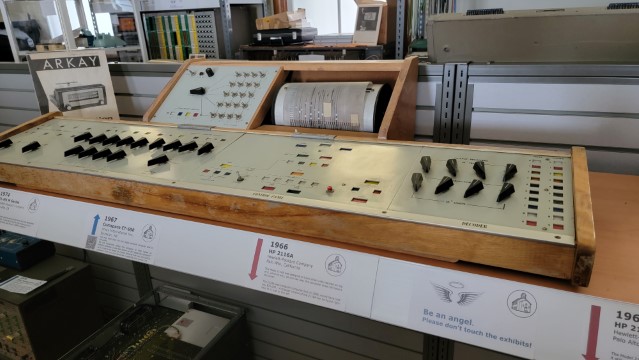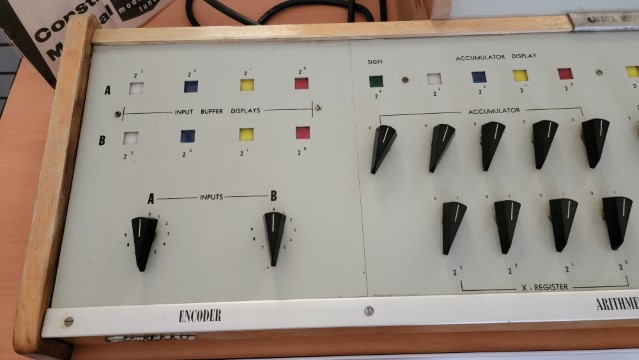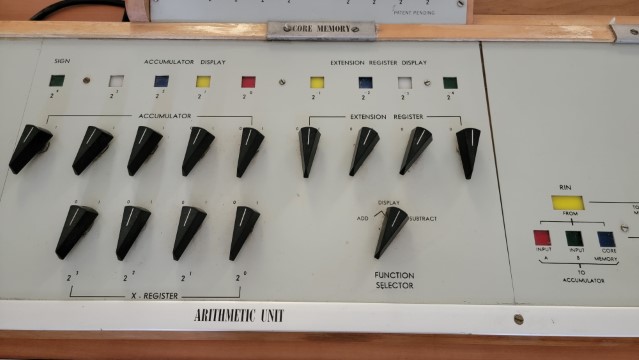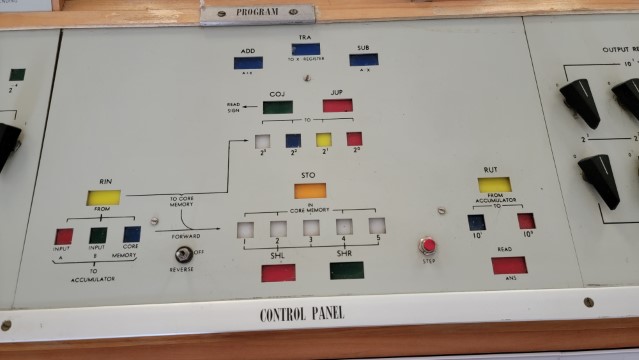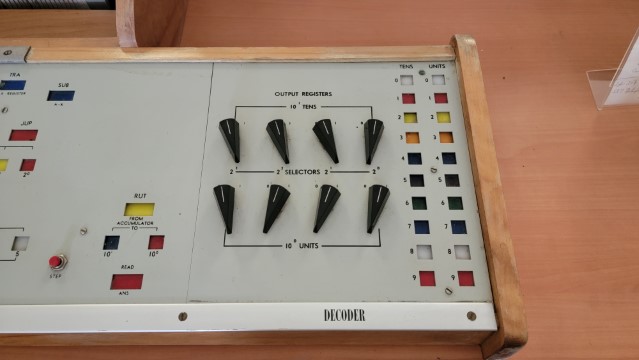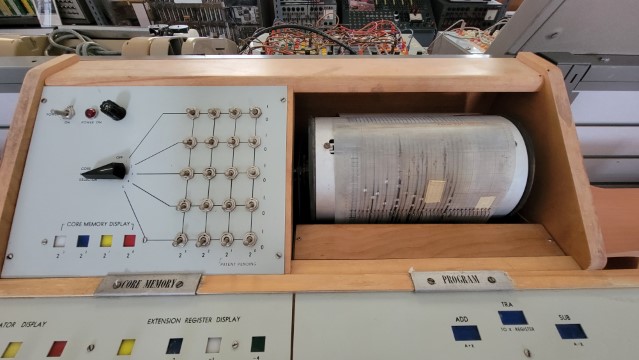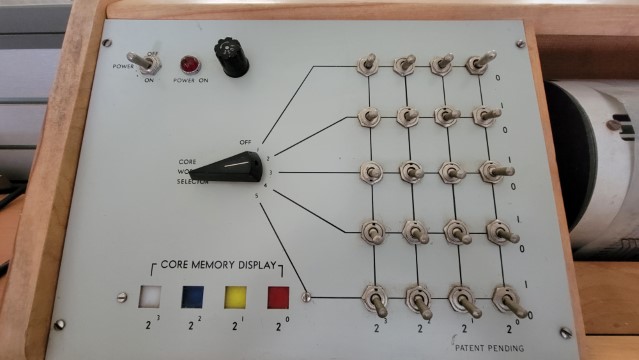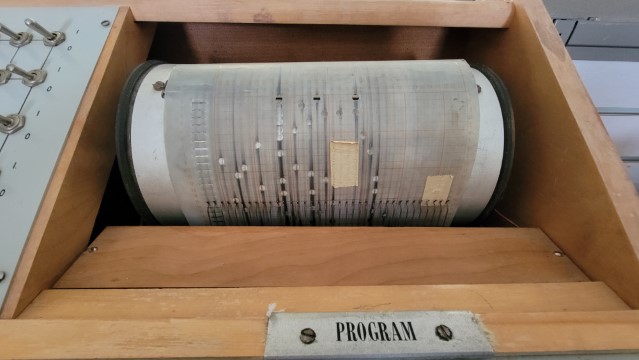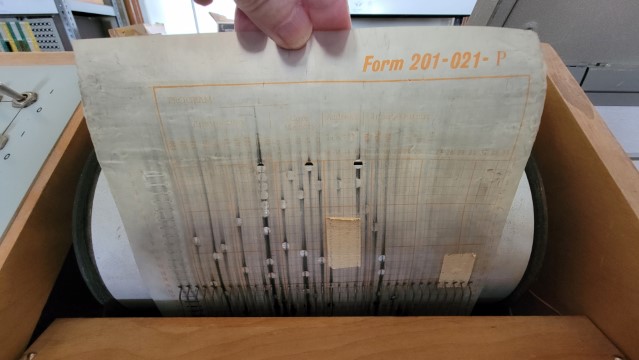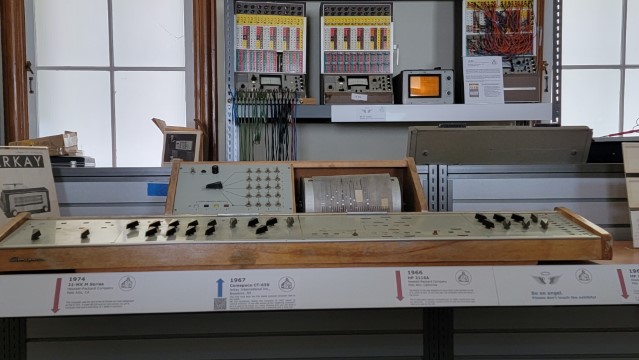Computer Trainer Model 650

Developed by Irving Becker, who unfortunately died December 2005, the CT-650 was one of the earliest digital personal computers. The CT-650 is likely one of the earliest digital personal computers ever made. One could make the argument that it was the first. (Depends on how you evaluate the Minivac-601 and Minivac-6010).
Updated Oct. 2019): We are tentatively dating this computer to 1967 based on indirect evidence. The Comspace Corporation was granted a copyright for a "General Operating Manual for Arkay CT-650 computer trainer" on June 22, 1967.1 The manual is described as being for an "Arkay CT-650 desk-top computer trainer". What strikes me as odd about this is that the book upon which this computer is supposedly based was also published in 1967. Would Mr. Becker have had time to put together an operating manual?
By the 1960’s he was developing many educational products including the Computer Trainer-650 and a cardboard kit for Bell Laboratories called “CARDIAC” (a reference to its cardboard construction and the names of other kits like Brainiac and Geniac).
Irving was dedicated to education and even made a special version of the CT-650 that was made for blind students. Aside from Braille lettering, the bulbs under each light were extra strong so as to generate more heat…that way the student could “read” the results by feeling which lights were lit.
The CT-650 is sometimes called the "paperclip computer" which is a reference to a 1967 book entitled How To Build A Working Digital Computer. The book describes how to make a computer out of things one might find around the house...such as tin cans, screws, paperclips and even wooden spools of thread. The design of the CT-650 seems to have relied on the book's plans and, therefore, it is called the "paperclip computer".
The computer is 54" in length by 22" in depth. It was built for educational use with six clearly labeled sections:
At some point before July 1980, Comspace Corporation moved from Brooklyn to Farmingdale, Long Island.
1According to the Library of Congress' Catalog of Copyright Entries: Third Series, Volume 21, Part 1, Number 2, Section 1 on page 1,690 (God bless the LOC for keeping track of information!) copyright #A925698 was issued to Comspace Corporation.
Updated Oct. 2019): We are tentatively dating this computer to 1967 based on indirect evidence. The Comspace Corporation was granted a copyright for a "General Operating Manual for Arkay CT-650 computer trainer" on June 22, 1967.1 The manual is described as being for an "Arkay CT-650 desk-top computer trainer". What strikes me as odd about this is that the book upon which this computer is supposedly based was also published in 1967. Would Mr. Becker have had time to put together an operating manual?
By the 1960’s he was developing many educational products including the Computer Trainer-650 and a cardboard kit for Bell Laboratories called “CARDIAC” (a reference to its cardboard construction and the names of other kits like Brainiac and Geniac).
Irving was dedicated to education and even made a special version of the CT-650 that was made for blind students. Aside from Braille lettering, the bulbs under each light were extra strong so as to generate more heat…that way the student could “read” the results by feeling which lights were lit.
The CT-650 is sometimes called the "paperclip computer" which is a reference to a 1967 book entitled How To Build A Working Digital Computer. The book describes how to make a computer out of things one might find around the house...such as tin cans, screws, paperclips and even wooden spools of thread. The design of the CT-650 seems to have relied on the book's plans and, therefore, it is called the "paperclip computer".
The computer is 54" in length by 22" in depth. It was built for educational use with six clearly labeled sections:
- Core Memory
- Program Drum
- Input Unit
- Arithmetic Unit
- Control Unit
- Output Unit.
At some point before July 1980, Comspace Corporation moved from Brooklyn to Farmingdale, Long Island.
1According to the Library of Congress' Catalog of Copyright Entries: Third Series, Volume 21, Part 1, Number 2, Section 1 on page 1,690 (God bless the LOC for keeping track of information!) copyright #A925698 was issued to Comspace Corporation.
Viewer Stories & Comments
William Berson Westport, USA December 29, 2020
RE: Arkay CT-650 Computer th I have some first hand knowledge of this early device, as my first (summer ) job during high school and college was to write the first programs for it and to do the production engineering for its manufacture. I knew Irving Becker and his family well. The mystery concerning the "how to build a working digital computer book" is simple. The CT-650 was copied from the design in the book. As a matter of fact the author sued Becker and Comspace on that basis, unsuccessfully.... with the judge ruling that as the CT-650 was not a kit and not made of paperclips, etc. it did not infringe. I (and Becker's son Nelson), carried the first CT-6t50's around the country, making the rounds of potential customers and tradeshows in the education market in the mid 1960's, with me demonstrating that even a high schooler could use it. As the book described, it was not a computer at all, but rather a manually operated simulator of a 1401 basic configuration, There was no processing capability, but the input and output sections were hardwired to convert decimal switch digital settings to a lighted binary number display and visa versa. These sections were borrowed from the design of various A/D and D/A trainers that were already on the market (by others) prior to Comspace's offering. The 'memory drum', was an aluminum cyinder with spring steel contactors which could read holes in a mylar sheet that represented various instructions ain a program. The instructions served only to light indicator lamps which cued the operator on how to transfer various 4 bit numbers around the machine. The arithmetic section was also hard-wired to add 4 bit numbers via SPST switches and indicator lamps. In all, less than 100 were made, but the unit was a success in bumping up Comspace's stock on the NASDEC. Uncredited in the published history of this saga, is Fred Barrett, who was the chief engineer of Comspace and who, I believe, designed the details of CT-650. Barrett, a black man, by the way practically single-handedly engineered Comspace's products. Irving Becker was a man of vision and intelligence, and kind to a young kid who was a computer geek, before the word had been invented.
RE: Arkay CT-650 Computer th I have some first hand knowledge of this early device, as my first (summer ) job during high school and college was to write the first programs for it and to do the production engineering for its manufacture. I knew Irving Becker and his family well. The mystery concerning the "how to build a working digital computer book" is simple. The CT-650 was copied from the design in the book. As a matter of fact the author sued Becker and Comspace on that basis, unsuccessfully.... with the judge ruling that as the CT-650 was not a kit and not made of paperclips, etc. it did not infringe. I (and Becker's son Nelson), carried the first CT-6t50's around the country, making the rounds of potential customers and tradeshows in the education market in the mid 1960's, with me demonstrating that even a high schooler could use it. As the book described, it was not a computer at all, but rather a manually operated simulator of a 1401 basic configuration, There was no processing capability, but the input and output sections were hardwired to convert decimal switch digital settings to a lighted binary number display and visa versa. These sections were borrowed from the design of various A/D and D/A trainers that were already on the market (by others) prior to Comspace's offering. The 'memory drum', was an aluminum cyinder with spring steel contactors which could read holes in a mylar sheet that represented various instructions ain a program. The instructions served only to light indicator lamps which cued the operator on how to transfer various 4 bit numbers around the machine. The arithmetic section was also hard-wired to add 4 bit numbers via SPST switches and indicator lamps. In all, less than 100 were made, but the unit was a success in bumping up Comspace's stock on the NASDEC. Uncredited in the published history of this saga, is Fred Barrett, who was the chief engineer of Comspace and who, I believe, designed the details of CT-650. Barrett, a black man, by the way practically single-handedly engineered Comspace's products. Irving Becker was a man of vision and intelligence, and kind to a young kid who was a computer geek, before the word had been invented.
|
Copyright © 2024 by Early Computers Project, All Rights Reserved. |


